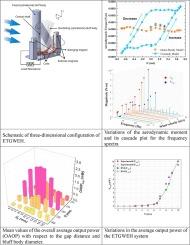开发新型尾流诱导旋转奔腾风能收集器并确定其工作机制
IF 7.9
1区 工程技术
Q1 ENGINEERING, MECHANICAL
引用次数: 0
摘要
本研究提出了一种新型、高性能的电磁风能收集系统,该系统利用尾流诱导旋转奔腾。其设计思想基于这样一个前提:下游崖体的角位移与对其产生的扭矩之间存在多个时间延迟,从而导致系统不稳定。本研究采用了双重电磁系统,以有效传递扭转弹性并将机械能转化为电能。此外,本研究首次以自主形式报告了与尾流诱发的奔腾现象相关的数学模型,以解释导致系统不稳定的空气动力记忆效应。为了确定拟议的能量收集系统中出现的旋转奔腾现象的机理,首先进行了全面的计算流体动力学分析。随后,通过傅里叶分析和三角函数关系,将以下游崖体角位移为单位的气动力矩图转化为非线性自治形式。为了确定最终的系统配置,利用各种几何参数进行了一系列初步和主要实验。随后,进行了特征分析,并对一组延迟微分方程进行了求解和分析,以确定系统的稳定性,并预测其在各种条件下的动态和能量行为。模型结果与实验结果之间的比较显示两者吻合良好,验证了所提出的自主非线性时延模型的准确性。从本研究如何提供实用价值的角度来看,城市地区常用的各种柱形障碍物会对传统的基于疾驰的能量收集器的性能产生负面影响;但对于本研究提出的系统,这些障碍物会产生涡流导致不稳定,从而有助于提高能量收集效率。本文章由计算机程序翻译,如有差异,请以英文原文为准。

Development of a novel wake-induced rotational galloping wind energy harvester and the identification of its working mechanism
This study proposes a novel, high-performance electromagnetic wind energy harvesting system using wake-induced rotational galloping. The design idea is based on the premise that there exist multiple time delays between the angular displacement of a downstream bluff body and the torque generated on it, which induces system instability. A two-fold electromagnetic system was employed to efficiently impart torsional elasticity and convert mechanical energy into electrical energy. Furthermore, this study reports, for the first time, a mathematical model associated with wake-induced galloping in an autonomous form to explain the aerodynamic memory effect that causes system instability.
To identify the mechanism of the rotational galloping phenomenon occurring in the proposed energy harvesting system, comprehensive computational fluid dynamic analyses were first performed. Subsequently, the resulting aerodynamic moment diagram, in terms of the angular displacement of the downstream bluff body, was transformed into a nonlinear autonomous form through a Fourier analysis and trigonometric relations. The extended Hamilton’s principle was applied to derive a set of coupled governing equations, which were then combined with the autonomous form of the aerodynamic moment.
To determine the final system configuration, a series of preliminary and main experiments were performed with various geometric parameters. Subsequently, an eigen-analysis was performed, and a set of delay differential equations was solved and analyzed to determine the system stability and predict its dynamic and energetic behaviors under various conditions. A comparison between the results of the model with those of the experiment showed a good agreement, validating the accuracy of the proposed autonomous nonlinear time-delay model. The proposed energy harvesting system achieved an average output of 9.3 mW and a power density of 131 W/m3 at a wind velocity of 10 m/s, illustrating its efficiency and optimal energy harvesting performance.
From the viewpoint of how this study offers practical value, various column-shaped obstacles commonly used in urban areas negatively impact the performance of traditional galloping-based energy harvesters; however, with the proposed system, they generate vortices to cause instability, thereby helping improve energy harvesting efficiency.
求助全文
通过发布文献求助,成功后即可免费获取论文全文。
去求助
来源期刊

Mechanical Systems and Signal Processing
工程技术-工程:机械
CiteScore
14.80
自引率
13.10%
发文量
1183
审稿时长
5.4 months
期刊介绍:
Journal Name: Mechanical Systems and Signal Processing (MSSP)
Interdisciplinary Focus:
Mechanical, Aerospace, and Civil Engineering
Purpose:Reporting scientific advancements of the highest quality
Arising from new techniques in sensing, instrumentation, signal processing, modelling, and control of dynamic systems
 求助内容:
求助内容: 应助结果提醒方式:
应助结果提醒方式:


